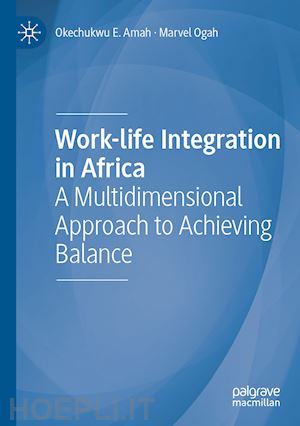

Questo prodotto usufruisce delle SPEDIZIONI GRATIS
selezionando l'opzione Corriere Veloce in fase di ordine.
Pagabile anche con Carta della cultura giovani e del merito, 18App Bonus Cultura e Carta del Docente
This book examines how individuals and organizations in Africa have found ways to integrate work and life roles effectively. It reflects on the notions that while many cultures have embraced women’s participation in the workplace, African culture has been more resistant to change thereby forcing companies and employees to invent their own solutions. This presents its own set of challenges, for example African organizations are generally not up to speed with the family-friendly policies that are required in the modern workplace; the effectiveness of such policies is questionable and there is an increasing realization that work-family policies are not the only way to achieve work-life integration and others may be considered, such as workplace mentoring and introducing incentives.
With this in mind the authors consider multiple approaches to balancing work and life responsibilities with emphasis on three perspectives, namely organizational, individual and family and cultural.The book highlights and examines the joint responsibility that organizations, leaders and individuals have in achieving work life integration. Secondly the book considers why work-life integration initiatives fail and identifies the sources and remedies for these failures. Each chapter discusses the role of the identified dimensions necessary for collective achievement of work-life integration, while the final chapter sets out further research avenues and a conceptual framework that brings together the findings of the book.
Chapter 1: Introduction: Overview of the Book and Book Chapters.- Chapter 2: Work-life Integration: Overview and Trends.- Chapter 3: Organizational Production Process and Work-Life Integration.- Chapter 4: Technology and its Impact on Work-life Integration - Chapter 5 : Family Friendly Policies: Trend and Expectations in Africa.- Chapter 6: Evaluation of the Contributions of Work-Life Friendly Policies in Managing Work-Life Integration in Africa.- Chapter 7: Leadership and Organizational Climate: Effects on Work-life Integration. Chapter 8 : Understanding and Evaluation of Self: Role in Work-life Integration.- Chapter 9: Meaning of Life and Successful Life: Work-life Integration. Chapter 10: Understanding the Family Structure in Africa: Role in Work-life Integration.- Chapter 11: Revisiting the Gender Ideology: Traditional and Egalitarian Family Role Definition in Africa.- Chapter 12: Understanding the Multidimensional and Multifunctional Approach in Managing Work-life Integration .- Chapter 13: Future Directions of Work-life Integration Research in Africa.
Dr Okechukwu Amah facilitates sessions in Management Communication, Human Resources, Leadership and Human Behaviour in Organisations at Lagos Business School. Previous to this he was a part-time lecturer at the Lagos State University, where he taught MBA students Organisational Behaviour, Organisational Theory, Business Policy and Management. He has also facilitated sessions in customised programmes for NLNG, and actively reviews articles for the annual meetings of the American Academy of Management and Southern Management Association. Currently, Dr Amah is researching work/family conflict and facilitation, employee engagement relationships, as well as organisational citizenship and servant leadership behaviour in Nigeria.
He is a member of the Society of Petroleum Engineers, Nigerian Academy of Management, American Academy of Management, Society of Human Resources Management and Southern Management Society.
Dr Marvel Ogah is a full-time faculty and facilitates sessions in Operations Management at Lagos Business School. His research areas include supply chain, lean methodology, service management, productivity cum process improvement initiatives in business organisations. He is currently working on the following research areas: digital supply chain, lean implementation bottlenecks, evolution of quality systems in Nigeria, and productivity cum employee change strategies in manufacturing organisations.











Il sito utilizza cookie ed altri strumenti di tracciamento che raccolgono informazioni dal dispositivo dell’utente. Oltre ai cookie tecnici ed analitici aggregati, strettamente necessari per il funzionamento di questo sito web, previo consenso dell’utente possono essere installati cookie di profilazione e marketing e cookie dei social media. Cliccando su “Accetto tutti i cookie” saranno attivate tutte le categorie di cookie. Per accettare solo deterninate categorie di cookie, cliccare invece su “Impostazioni cookie”. Chiudendo il banner o continuando a navigare saranno installati solo cookie tecnici. Per maggiori dettagli, consultare la Cookie Policy.